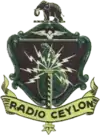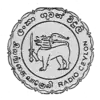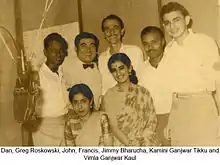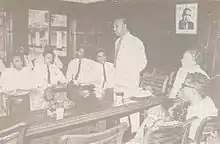Radio Ceylon
Radio Ceylon (Sinhala: ලංකා ගුවන් විදුලි සේවය Lanka Guwan Viduli Sevaya, Tamil: இலங்கை வானொலி, ilankai vanoli) is a radio station based in Sri Lanka (formerly Ceylon) and the first radio station in Asia. Broadcasting was started on an experimental basis by the colonial Telegraph Department in 1923, just three years after the inauguration of broadcasting in Europe.
  | |
| Type | radio, and online |
|---|---|
| Country | |
| Availability | National International |
| Owner | Government of Sri Lanka |
Launch date | 1925 (radio) 1967 (incorporation) |
Former names | Colombo Radio, Radio SEAC (1925–1948) |
Official website | www |
History
The history of Radio Ceylon dates back to 1925, when its first precursor, Colombo Radio, was launched on 16 December 1925 using a mediumwave radio transmitter of one kilowatt of output power from Welikada, Colombo. Commenced just 3 years after the launch of BBC, Colombo radio was the first radio station in Asia and the second oldest radio station in the world.[1][2][3][4]
This new medium of mass communication not only became increasingly popular in the years that followed, but also quickly evolved into a medium of national character, which led to the “Radio Service” being organised as a separate department of the government of Ceylon (currently Sri Lanka) in 1949. Subsequently, in 1967, the Department of Broadcasting was transformed into its present statutory form of a state corporation by the Ceylon broadcasting corporation Act. No 37 of 1966[5][6] of the parliament of Ceylon,[7] thereby assuring increased autonomy and flexibility in the operations of the new organization.
The organisation acquired its present name, Sri Lanka Broadcasting Corporation, with the transition of the state into the status of Republic of Sri Lanka on 22 May 1972. SLBC ( Stand for Sri Lanka Broadcasting Corporation) has since continued in the same legal status as a state corporation, and is currently listed under the scope of the ministry of Information and Media of the Government of Sri Lanka.[8][9]
Transition from AM to FM
SLBC relied on mediumwave as its primary mode of domestic broadcasting until the 1990s. Some sporadic FM broadcasts were already introduced at several relay stations more as a means of expanding the broadcasts to medium wave repeaters stations. However, by the late 1980s.
This was followed by the ‘Island FM Development Project’ that was launched in year 1995. The objectives of the project were to develop an Islandwide multi-channel FM stereo broadcast transmission network and to divest the costly domestic medium wave transmitting stations, which were typically broadcasting only one or two programme channels per transmitting station. By 1999, more than 95% country’s total population was being covered by SLBC’s FM transmissions with nearly 90% of them receiving all six nationwide channels.[10]
Radio services
Currently, SLBC's domestic FM network broadcasts 6 radio stations on a nationwide basis, which are:
- Sinhala Swadeshiya Sevaya’ (Sinhala National Service)
- Tamil National Service
- English Service
- City FM (Sinhala)
- Velenda Sevaya’ (Sinhala Commercial Service)
- Thendral (Tamil Commercial Service)
Hindi service
Radio Ceylon had a Hindi service that was launched in the early 1950s. Millions of rupees in terms of advertising revenue came from India through the efforts of Dan Molina, Frank Courtney, and S. Hariharan (the director of the Malayalam film Vayanadan Thamban). The three operated Radio Advertising Services as the advertising agents of Radio Ceylon. The station employed some of the most popular Indian announcers who played a vital role in establishing Radio Ceylon as the 'King of the airwaves' in South Asia, among them, the Ganjwar sisters, Vimla and Kamini, Vijay Kishore Dubey, Gopal Sharma, Hasan Razvi, Kumar and Manohar Mahajan, Sunil Dutt (who went on to become a film star in Bollywood), Ameen Sayani and elder brother Hamid Sayani, though not hired by Radio Ceylon became popular by using Radio Ceylon for broadcasting programs like "Binaca Geetmala" (first broadcast in 1952) and "Lipton Ke Sitaare."

Its most popular features were film songs. While the golden age of Hindi-language film music was in the 1950s and 1960s, the station popularised movie songs, including the ones form Asha Bhosle,[11] Lata Mangeshkar, K.L. Saigal, Kishore Kumar, Mukesh, Mohammed Rafi, S. Janaki and others. The radio station took advantage of the situation as Bollywood film music was banned by All India Radio and other Indian radio stations at the time.[12] This led to increased listenership for radio programmes such as Binaca Geetmala. The Binaca Hit Parade was presented by Greg Roskowski, it was a countdown of English pop music beamed on the Commercial Service and the All Asia Service. Having heard the programme, the audience flooded the station with letters requesting a count down of Hindi-language filmi songs and the idea of Binaca Geetmala was born.[13]
Radio Ceylon also popularised English songs of Indian popular musicians - they went on to score huge hits, among them Uma Pocha (Bombay Meri Hai), Usha Uthup who has the rare distinction of singing Sri Lankan baila songs with ease and the Anglo-Indian star, Ernest Ignatius (who went on to be a success in Sir Andrew Lloyd Webber's 'Bombay Dreams' in London) had a massive hit, I married a female wrestler, on the Hindi service.[14]
The station recorded jingles and beamed them on the All Asia Service - from Lux soap to Coca-Cola. Major brands queued up for their jingles to be broadcast live by the announcers of Radio Ceylon, such was the station's advertising power.[15] M
Ceylon Broadcasting Corporation

Radio Ceylon became a public corporation on 30 September 1967 and the station's name was changed to the Ceylon Broadcasting Corporation. Prime Minister Dudley Senanayake appointed a distinguished Ceylonese civil servant, Neville Jayaweera to head the CBC.
When Sri Lanka became a republic in 1972 the station underwent yet another name change as the Sri Lanka Broadcasting Corporation (SLBC).
In December 2005 Sri Lanka celebrated its 80th anniversary .[16] On January 5, 2007 the Sri Lanka Broadcasting Corporation celebrated forty years as a public broadcasting corporation.
See also
References
- History of broadcasting
- "Gramophones Of Ceylon".
- Clifford Dodd
- Mixed Signals Radio Broadcasting Policy in India (page: 2176) (PDF).
- "Sri Lanka Consolidated Acts".
- Radio in Sri Lanka
- "Parliament Of Sri Lanka". Missing or empty
|url=(help) - "Welcome to the Ministry of Mass Media and Information".
- List of ministries of Sri Lanka
- "Sri Lanka Media Stats".
- Roy, Sandip (21 September 2005). "ASIAN POP:The life and times of Asha Bhosle, enchanting songstress of Bollywood, now appearing with Kronos Quartet (San Francisco Chronicle, USA)". The San Francisco Chronicle. Retrieved 4 September 2008.
- "That mesmeric voice (Metro Plus, Chennai-The Hindu, India)". Archived from the original on 22 March 2010. Retrieved 4 September 2008.
- "Reference to Greg Roskowski and the Binaca Hit Parade on Radio Ceylon on 'Who moved my Aiwaves?' (businessgyan.com)". Archived from the original on 26 October 2007. Retrieved 11 September 2008.
- "Reference to Ernest Ignatius and his hit 'I married a female wrestler'". Archived from the original on 6 August 2008. Retrieved 12 September 2008.
- "It's All in the Name(The Hindu, India)". Retrieved 4 September 2008.
- "Eighty Years in Broadcasting in Sri Lanka (Daily News, Colombo)". Archived from the original on 25 September 2008. Retrieved 4 September 2008.
Bibliography
- Wavell, Stewart. - The Art of Radio - Training Manual written by the Director Training of the CBC. - Ceylon Broadcasting Corporation, 1969.
- Ceylon, Radio. - Standards of Broadcasting Practice - Commercial Broadcasting Division. - Radio Ceylon, 1950.
- Buying and Believing: Sri Lankan Advertising and Consumers in a Transnational World by Steven Kemper, (Paperback - 7 Jan 2002)
- Satchmo Blows Up the World: Jazz Ambassadors Play the Cold War by Penny Von Eschen, Harvard University Press, 2006, ISBN 0674022602
- Encyclopedia of Business in Today's World, [Hardcover], Charles Wankel (Editor), Sage Publications, Inc (1 Sep 2009), ISBN 141296427X
- Handbook of the Media in Asia, [Hardcover], Professor Shelton A Gunaratne (Editor), Sage Publications Pvt. Ltd (8 Jun 2000), ISBN 0761994270
External links
- Vernon Corea The Golden Voice of Radio Ceylon
- Sri Lanka Broadcasting Corporation - Live Streaming
- Sinhala Radio Live Streaming - Test
- SLBC-creating new waves of history
- Eighty Years of Broadcasting in Sri Lanka
- - Lata Mangeshkar and Radio Ceylon, in the Marathi language
- A selection of articles on Tamil Announcers of the Sri Lanka Broadcasting Corporation
- Radio Ceylon Facebook Group
- Facebook Community Page on Radio Ceylon